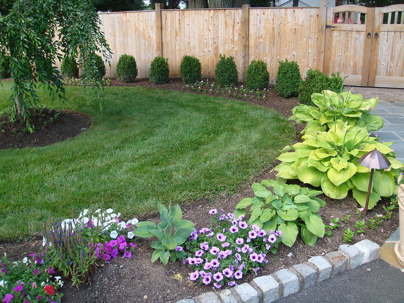 When you invest in a brand new home, you want to have a fresh and well-manicured lawn. The appearance of your yard can dramatically impact the curb appeal of your home. After winter, performing lawn care maintenance has never been more important. After a long rest throughout late fall and winter, your lawn will wake up hungry and ready to grow. If you take the time to learn how to feed your lawn, strengthen it, and get it off to the right start in the spring, your yard will be the envy of the block.
When you invest in a brand new home, you want to have a fresh and well-manicured lawn. The appearance of your yard can dramatically impact the curb appeal of your home. After winter, performing lawn care maintenance has never been more important. After a long rest throughout late fall and winter, your lawn will wake up hungry and ready to grow. If you take the time to learn how to feed your lawn, strengthen it, and get it off to the right start in the spring, your yard will be the envy of the block.
Doing the Right Things At the Right Time
You don’t have to hire a professional lawn care company to rejuvenate your lawn and then maintain it, but it’s definitely an option. If you’re willing to take time to learn what steps you’ll need to take and to put in the time, you can feed your lawn and prevent weeds from growing at the same time. Doing lawn care on your own can give you a feeling of pride in the way your home looks from the outdoors.
Steps You’ll Need to Take in Early Spring
When it’s about time for the groundhog to see his shadow, it’s time to start preparing your lawn for the spring. After a very tough winter, your lawn is going to wake up from a slumber like a hungry bear in search of food. Too bad your grass can’t simply get up and hunt!
If you want to ensure that you’re nurturing a well-fed lawn early spring, once the grass starts to green up, is the perfect time to start feeding it. This will ensure that your lawn grows in lush and healthy as the flowers start to bloom. Here are some valuable steps you’ll need to rejuvenate your lawn at the beginning of the best season for plant life:
Aeration
Soil compaction can lead to a loss of oxygen and a lack of nutrients. Aeration should happen in early spring, or late fall, but never in the summer as hot weather easily stresses your lawn out. By renting an aerator in early spring or having someone come in and aerate for you before you overseed, you can prevent compaction and allow more oxygen to reach the roots of your lawn.
Overseeding
Next, you should overseed, which is the process of adding lawn soil and grass seed over top of your existing lawn. If you want a thick lawn that looks better than all of the rest, this step is essential. Spread about ¼ inch of lawn soil evenly and rake out .Next spread the grass seed and starter fertilizer over the soil and water daily until the seed grows well. Overseeding will fill in patches, make the lawn denser and help prevent weed growth.
Feeding the Lawn
After you seed, you can feed the lawn with an all-purpose lawn fertilizer. A fertilizer with higher nitrogen content will rapidly green up your lawn. Choose a 20 -10 -10 for spring. This will be the first feeding of the year and should be repeated late in spring as well, about 8 weeks later. The best-looking lawns are lawns that are fed four times a year.
Step You’ll Need to Take Once Seeds Take Root
Now that early spring is over and the overseeding is flourishing and thriving, you’ll need to focus on keeping your lawn manicured and well-fed so that it’ll be able to stand up to all of the stress of the high temperatures that the summer brings. You know, that heat we all love, but can seriously damage your lawn? All of that early energy your fertilizing has provided is now being used and your grass (and the unwanted weeds) is flourishing. Here are several steps you’ll need to take to combat those pesky weeds without killing the grass you’ve worked so hard to nurture and feed.
Apply a Weed Prevent Product
Weed prevention products are designed to target dandelions and crabgrass. These products will prevent germination and aren’t designed to specifically kill the weeds that have already started to grow. If weeds are already polluting your grass, you’ll need to take another step.
Apply Weed-B-Gone
There are several broadleaf weeds that may have already started to grow. To control these, you can simply spray them with a Weed-B-Gone product that cuts off oxygen to the root. Make sure to check with city by-laws on what you can and can’t use before making a purchase.
Second Fertilizer Feeding
Now that eight weeks have passed, it’s time to feed your lawn again with an enriched turf builder fertilizer. By feeding your lawn with fertilizer again, you can make your lawn dramatically stronger and healthier before summer. Choose a 10-10-10 fertilizer now increases root mass and makes the blades of your grass lush and green.
Take time to apply the right products to your lawn at the right time of year and to understand what to do at specific times during the year. Spring is one of the most important seasons for your lawn. During this time, it’s imperative that you feed your lawn, nurture it, and supply your hungry lawn with everything that it needs to wake up from its winter nap and thrive during the ultimate growing season.
photo credit: Gregs Landscaping via photopin cc
